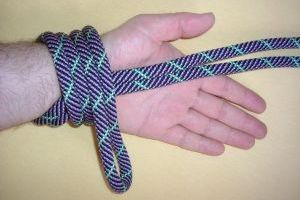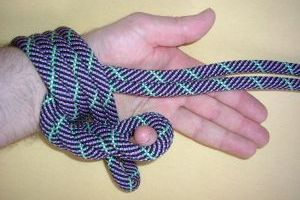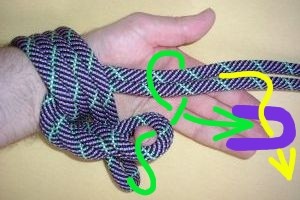Vor einer Weile ist mir dieser Knoten gezeigt worden, welcher für eine gute und flächige Lastverteilung aufs Handgelenk sorgt. Dummerweise hatte ich nicht mehr sämtliche Details im Kopf, als ich die dazu passenden Photos gemacht habe, deswegen fehlen mir Photos vom fertigen Knoten.
A while ago I have been shown this which spreads the load evenly on the wrist. Unfortunately I did not remember all the details when trying to take a photo series of this knot, thus I do not have a photo of the finished knot at present.

Erster Schritt.
Eigentlich sollte es noch eine Wicklung mehr sein, aber dafür
ist mein farbiges Seil leider leider ein wenig zu kurz.
First step. In principle one should pass the original bight three times around the wrist, not just twice, but my rope was just a little bit on the short side.

Zweiter Schritt.
Nachdem man noch etwas loses Seil unter dem Handgelenk durchgezogen hat,
verzwirbelt man das Ende typischerweise zwei Mal.
Second step. Twease some of the main rope under the turns so there is some slack at the shoulder end and then give this slack two half turns to create a loop.

Für den Burfleet-Knoten nimmt man nun das lose nach unten
hängende Seil (welches eigentlich noch deutlich länger sein
sollte als hier auf dem Photo gezeigt),
fädelt es durch die verdrillte Doppelseilbucht und legt dann
einen halben Schlag um das Verankerungsdoppelseil, wie es der
grüne Pfeil zeigt.
Zur Sicherung gegen versehentliches Lösen kann noch das Verankerungsseil gemäß dem gelben Pfeil durch die Seilbucht am Ende des grünen Pfeils durchgezogen werden.
For the Burfleet knot one now passes the bight and the 10-20 spare
inches through the twisted loop
and snugs the main rope back in to adjust the length of the twisted loop
so it sits nicely against the turns.
Then one passes the bight under the main rope
and back over the main rope but under itself.
If you want to secure the knot, follow the yellow arrow and
pass the loose ends from the main rope through the bight.
Als Faustregel, damit das Seil nicht zu eng ist, sollte man noch zwei Finger zwischen Seil und Handgelenk schieben können.
As a rule of thumb to avoid having the rope too tight one should always be able to stick two fingers in between rope and wrist.